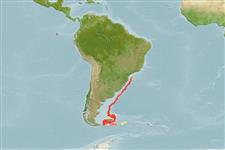>
Gadiformes (Cods) >
Macrouridae (Grenadiers or rattails)
Etymology: Coelorinchus: Greek, koilos = a hollow + Greek, rhyngchos = jaw (Ref. 45335).
More on author: Hubbs.
Environment: milieu / climate zone / depth range / distribution range
Ecologia
marinhas bentopelágico; não migratória; intervalo de profundidade 200 - 600 m (Ref. 1371). Deep-water; 26°S - 56°S, 64°W - 34°W (Ref. 1371)
Southwest Atlantic: southern Brazil to South Georgia.
Tamanho / Peso / Idade
Maturity: Lm ? range ? - ? cm
Max length : 38.0 cm TL macho/indeterminado; (Ref. 1371)
Espinhos dorsais (total) : 0; Espinhos anais: 0. The head large; the eyes also large; snout tipped with a scute of moderate size, not especially set off by its size or spines from the adjacent scales. Head ridges moderately supported by coarse scales. Most body scales with small fine, reclined spinules arranged in an irregular quincunx to sub parallel pattern. Overall color is medium brown to swarthy, darker on the abdomen and chest; the underside of the head with small melanophores; the fins are dusky, their inner bases black.
Frequently occurs below 350 m depth in winter. Feeds on benthic crustaceans and polychaetes (Ref. 54164).
Ciclo de vida ou comportamento de acasalamento
Maturities | Reprodução | Spawnings | Egg(s) | Fecundities | Larvas
Cohen, D.M., T. Inada, T. Iwamoto and N. Scialabba, 1990. FAO species catalogue. Vol. 10. Gadiform fishes of the world (Order Gadiformes). An annotated and illustrated catalogue of cods, hakes, grenadiers and other gadiform fishes known to date. FAO Fish. Synop. 125(10). Rome: FAO. 442 p. (Ref. 1371)
Status na Lista Vermelha da UICN (Ref. 130435)
Ameaça para os humanos
Harmless
Uso pelos humanos
Ferramentas
Relatórios especiais
Baixar XML
Fontes da internet
Estimates based on models
Preferred temperature (Ref.
123201): 3.3 - 14.6, mean 4.6 °C (based on 47 cells).
Índice de diversidade filogenética (Ref.
82804): PD
50 = 0.5000 [Uniqueness, from 0.5 = low to 2.0 = high].
Bayesian length-weight: a=0.00219 (0.00126 - 0.00381), b=3.16 (3.01 - 3.31), in cm total length, based on LWR estimates for this species & Genus-body shape (Ref.
93245).
Nível Trófico (Ref.
69278): 4.2 ±0.3 se; based on diet studies.
Resiliência (Ref.
120179): Baixo, tempo mínimo de duplicação da população 4,5 - 14 anos (Preliminary K or Fecundity.).
Fishing Vulnerability (Ref.
59153): Low to moderate vulnerability (28 of 100).
Climate Vulnerability (Ref.
125649): Low to moderate vulnerability (26 of 100).
Nutrients (Ref.
124155): Calcium = 21.3 [11.6, 49.8] mg/100g; Iron = 0.366 [0.166, 0.729] mg/100g; Protein = 15.7 [13.5, 18.1] %; Omega3 = 0.232 [0.104, 0.526] g/100g; Selenium = 18.5 [7.3, 44.3] μg/100g; VitaminA = 30.7 [6.4, 143.4] μg/100g; Zinc = 0.406 [0.264, 0.632] mg/100g (wet weight);
